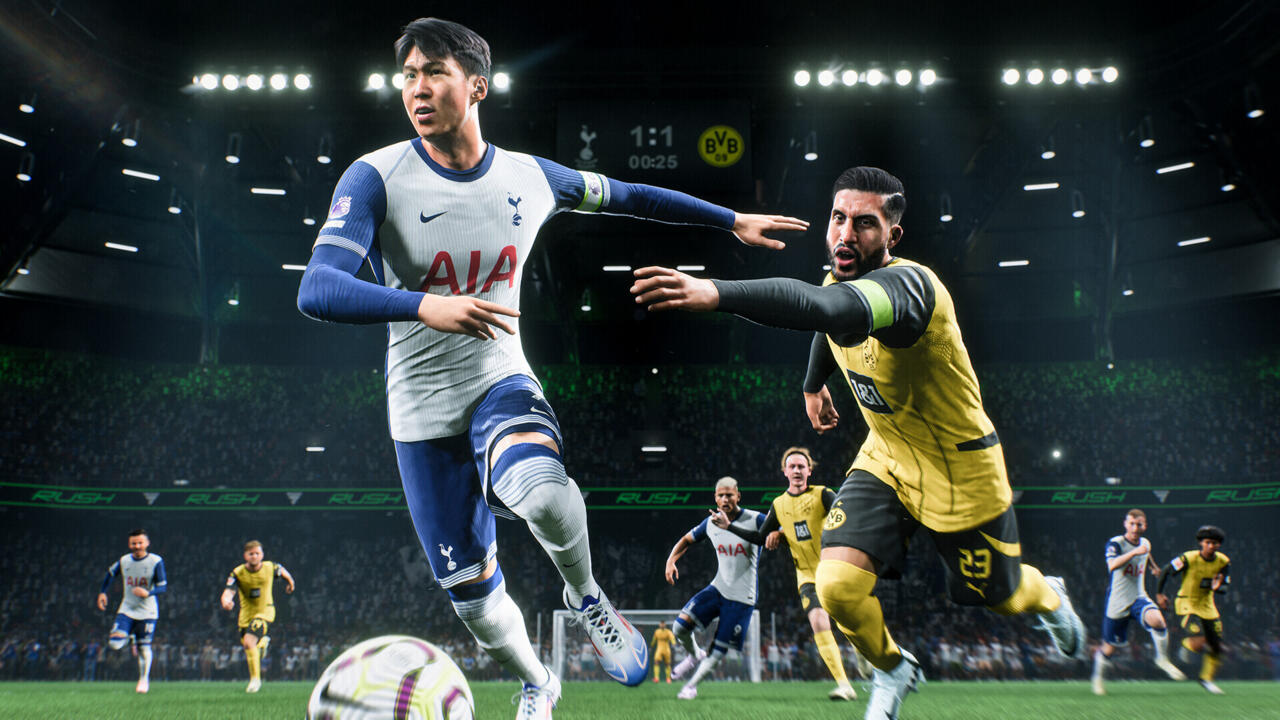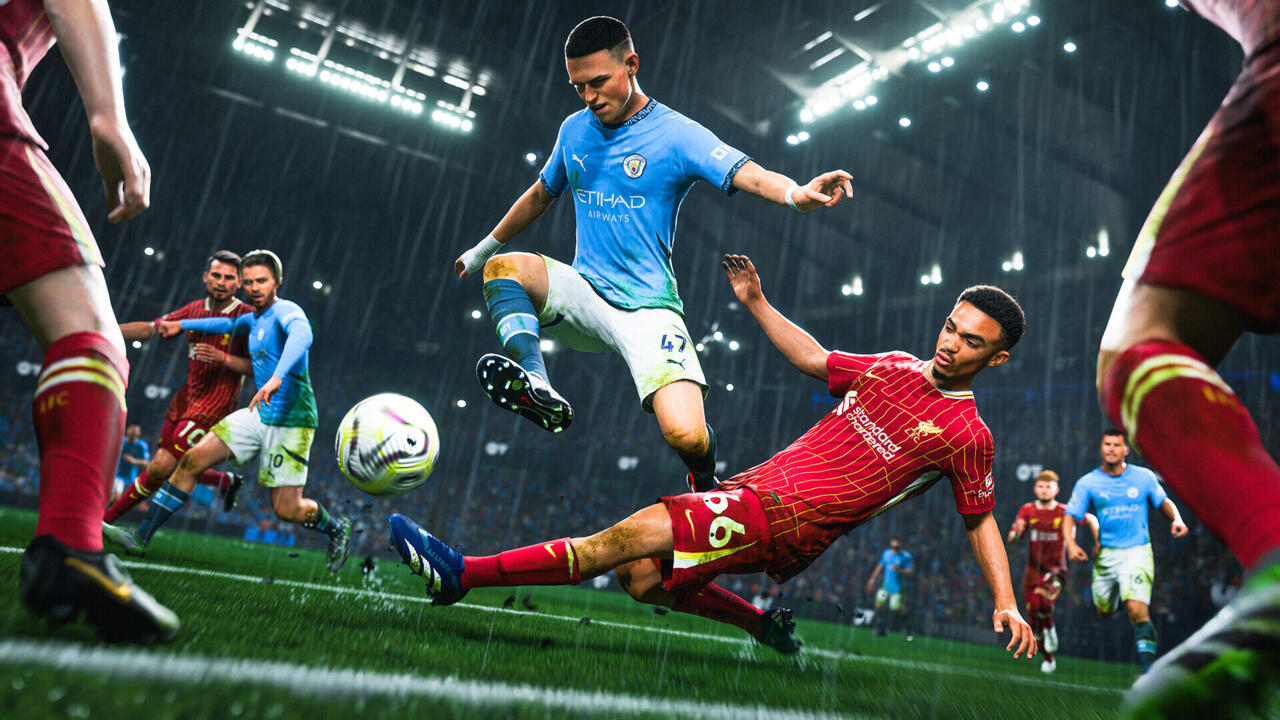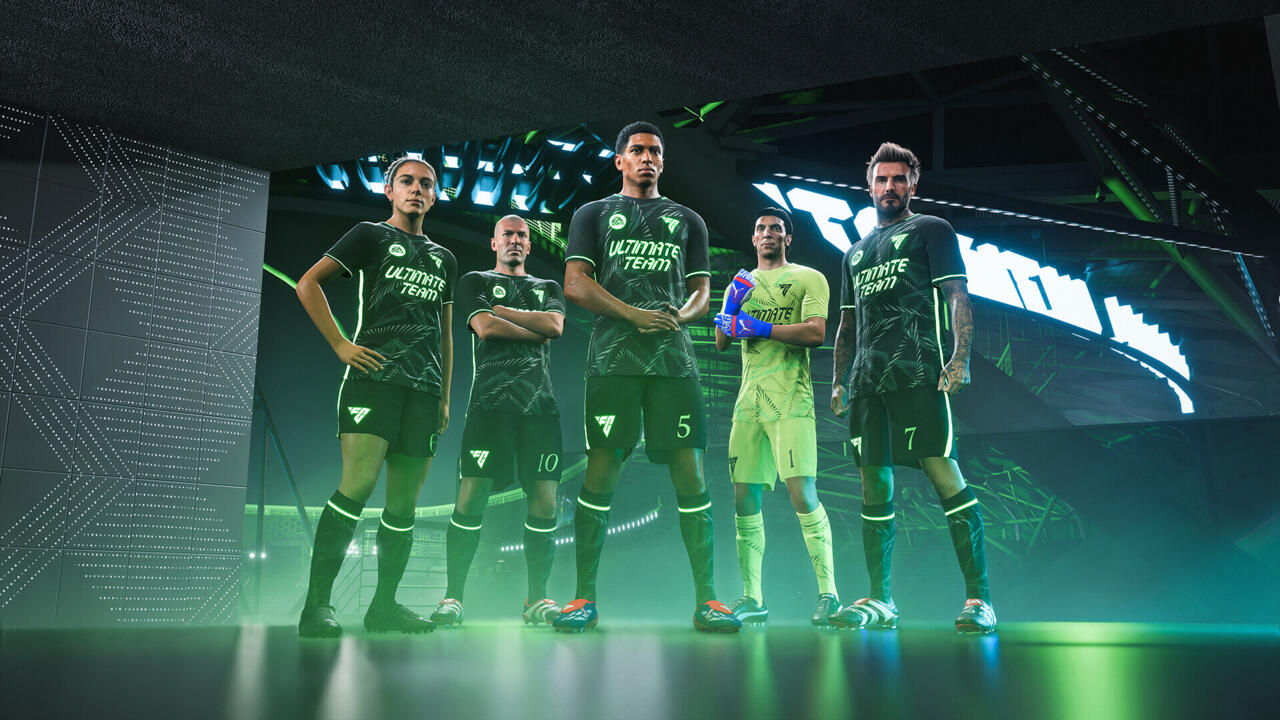You’re greeted by the legendary Zinedine Zidane upon booting up EA Sports FC 25 for the first time. The former French international and multi-Champions League-winning manager is keen to extol the virtues of tactics during an introductory video that feels more like the opening to a Football Manager game than EA’s latest footballing sim. The introduction of FC IQ is the reason behind this, putting Player Roles at the forefront in a comprehensive overhaul of the series’ tactics. It’s a significant change that, along with the new Rush mode, gives EA FC 25 two marquee new features to shout about. Beyond this, however, improvements to the game’s on-pitch action and suite of game modes are either incremental or nonexistent, in what feels like a half-step forward for the long-running series.
FC IQ is the driving force behind most of EA FC 25’s forward momentum. The previous tactics system has been discarded and replaced by a malleable set of new Player Roles that dictate how your team functions with much more variety than before. As a result, the team-wide aspects of any given tactic have been streamlined, simply letting you set the depth of your defensive line and pick a build-up style based on short passing, countering, or a balanced mix of the two. Once you’ve picked a strategy and a formation you’re happy with, you can begin applying specific roles to each player to really define its identity, balancing the risk and reward of certain roles and their impact on the team.
Every position has several Player Roles that govern a player’s movement and positioning when they don’t have the ball, both when your team has possession and when it doesn’t. A central midfielder, for instance, fits into one of five roles, ranging from a playmaker to a half winger. The latter is new and sees your center mid drift out wide–similar to how Kevin De Bruyne often plays for Manchester City–letting you create overloads on one side of the pitch or whip balls into the box with a more proficient crosser than either your winger or fullback. This introduces more ways for you to create chances and gives you something else to think about when devising a tactic, making the whole process much more engaging.
Most roles also have a Focus that alters how a player behaves within the confines of their role. You can set a half winger to play a more balanced game, alternating equally between attacking and defending, or give them the freedom to be more forward-thinking, abandoning their defensive responsibilities in favor of pushing the attack.

To fill this vacated space in the middle of the park, you might deploy one of your fullbacks with the new falseback role, which sees them drift centrally as an extra midfielder when you’re in possession. Not every fullback can perform such a specialized role adequately, however. In fact, no player is suited to every role, even if it’s in their preferred position, so Role Familiarity guides you in how best to set up your team. Someone like Vinícius Júnior can play as a winger without compromising his abilities, but switching to a role he’s accomplished on world-class at, such as an inside forward, will make him display more tactical and positional intelligence, resulting in better-timed runs and faster transitions from defense to attack.
This makes building a team in Career mode or Ultimate Team much more compelling than before. Do you construct a tactic and find players to fit it? Or do you ensure that each player is playing in their preferred role, regardless of what this does to the shape of your team? These are important considerations to make, adding another wrinkle to team-building that goes beyond numbered attributes like pace and shooting ability.

The formation you settle on–whether it’s 3-5-2, 4-3-3, or something else in between–determines the shape of your team when defending. The Player Roles within this formation might maintain the same shape once you transition to attack or morph into something entirely new. Fortunately, there’s a handy toggle that shows you how your players will position themselves both on and off the ball, and in practice, this makes for a lot more variance in the teams you’ll come up against. You could face two teams with the exact same formation, but depending on how they’ve tailored each individual Player Role, you’ll often notice a tangible difference in their approach.
Adding more variety to how players move and occupy certain positions is fantastic, but doubly so when there isn’t a discernible difference in how EA FC 25 actually feels to play compared to last year’s game. Sure, the general pace of play is slower–as is often the case at the start of each yearly cycle–and the plethora of new animations, particularly when shooting, make for some satisfying moments and goals. Yet it doesn’t do enough to distinguish itself as a positive step forward. There’s still a good game of football here, but any improvements are merely incremental, and it still comes saddled with the same long-standing issues. Tackling and player switching are both unreliable, goalkeepers are maddeningly inconsistent–pulling off wonder saves only to concede shots hit directly at them–and it’s still more effective to spam skill moves than break down defenses with intricate passing. It’s a shame that these problems still exist.

To make matters worse, the input delay currently affecting online matches results in a frustrating and sluggish experience when playing against others. Curiously, it’s not an issue in the new Rush mode, but trying to play Rivals matches in Ultimate Team is a slog. Even the game’s menus are afflicted by a similar issue, feeling like it’s constantly chugging behind your button inputs. This makes menu-heavy modes like Career and Ultimate Team aggravating to navigate. I fell foul of a number of crashes on PS5, too, most frequently when accessing the store to open new packs and at the end of games.
Fortunately, much like FC IQ, Rush is an excellent new addition to the series, replacing Volta with quick five-a-side matches (one AI goalkeeper and four outfield players) that promise frantic action and bundles of goals. These five-minute contests are played on a smaller pitch and are governed by a unique ruleset. Kick-offs, for instance, are similar to those in Rocket League, with both teams lining up in their own half before the ball is dropped into the center circle, resulting in a mad dash to the middle as both teams try to attain possession first. Meanwhile, offsides only trigger when in the final third, and red cards have been replaced by a blue variant that condemns the offending player to the sin bin for a whole minute. It’s chaotic fun and feels distinct enough from regular matches to provide a gratifying change of pace.

Rush is available in Kick Off, Career, Ultimate Team, and Clubs, so there are a few different ways to play. In Career mode, it’s used for youth tournaments, allowing you to play as your best wunderkinds and develop their attributes before they’re ready to step up to the first team. In Ultimate Team, you can hop into drop-in matches with three random players or play with friends, picking one player from your club to control. Sometimes, there are restrictions on the pool of players you can choose from, and you’re also incentivized to select players from specific leagues and nations to earn bonus points that go towards XP for the season pass. Drop-in matches are a bit of a crapshoot when it comes to finding good teammates. Some people will refuse to defend or pass, while others have seemingly no idea how the offside rule works. It’s easy to disrupt a game when there are only four players on each team, so it’s definitely preferable to play with friends if you can.
Aside from the inclusion of youth tournaments, Career mode has also been given attention in a few other areas. You’re now afforded more flexibility in how you customize the experience, from setting the leniency of your board’s expectations to speeding up or slowing down the development rate of your players. If you choose the simulation gameplay type, you must also contend with inclement weather. A windy afternoon will affect the ball’s trajectory, while a rainy downpour adds more zip to ground passes and causes players to occasionally slip. It’s disappointing that these effects aren’t a factor in online matches, but it makes sense in the name of balance.

The long-overdue inclusion of several major women’s leagues is another welcome addition to Career mode. You can even start a Player Career as one of the game’s Icons, though it’s odd that you’re limited to a meager four options considering how many reside in Ultimate Team. Regardless, who doesn’t want to start a Career with Thierry Henry starting up top for Stevenage? These may only be minor improvements, but they’re improvements nonetheless.
As for Ultimate Team, EA’s cash cow has seen very few changes, but the ones that have been introduced aren’t exactly positive. The rewards for racking up wins in Rivals have been downgraded despite the fact you now need to win 15 matches in a week rather than the previous seven. It’s a significant time commitment when you also factor in the other objectives you might potentially want to complete across Rush, Squad Battles, and Friendlies. On top of this, qualifying for Champions–where the greatest rewards are located–is now reserved for the best players. In the past, you only needed to win four games out of 10 to qualify. Now, you must win three out of five matches to earn your spot in the finals, a decision that feels like it was fueled by the mode’s pay-to-win microtransactions. Those who spend the most money are more likely to gain access to the best rewards.
There’s a lot to like about EA FC 25, from the overhauled tactics to the chaotic addition of Rush and a few welcome improvements to Career mode. It’s not a resounding victory, however. The on-field action has stagnated, maintaining its quality but also plenty of its flaws, while changes to Ultimate Team feel antagonistic in their design. In the near future, issues like input lag and its propensity to crash will hopefully be fixed, but the same is unlikely to be true for its long-standing problems. At the end of the day–to borrow common football player lingo–there’s fun to be had with EA FC 25, especially if you enjoyed last year’s game, but rather than taking a significant leap forward, it’s content to settle for midtable form.
